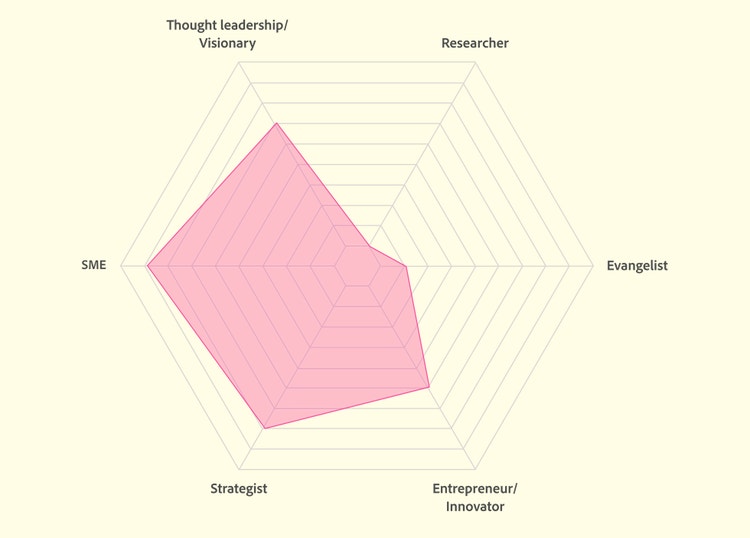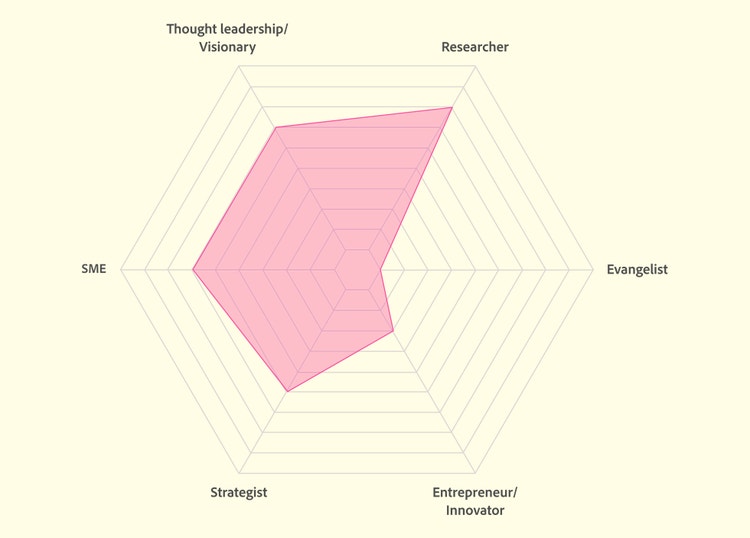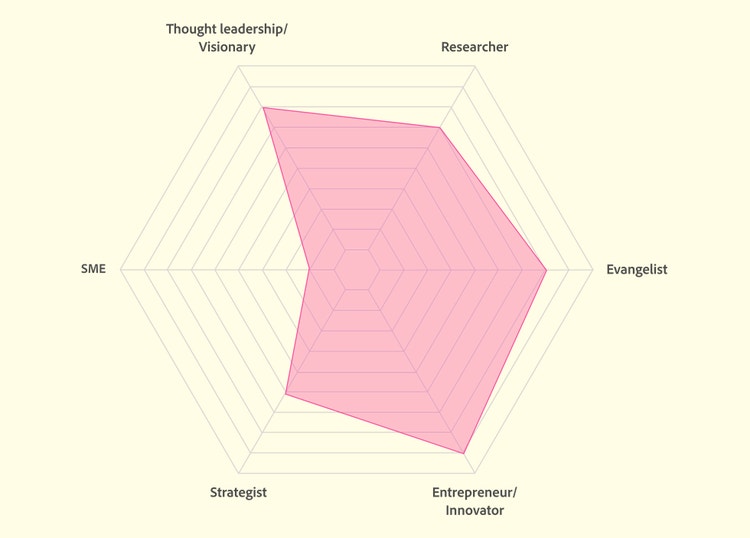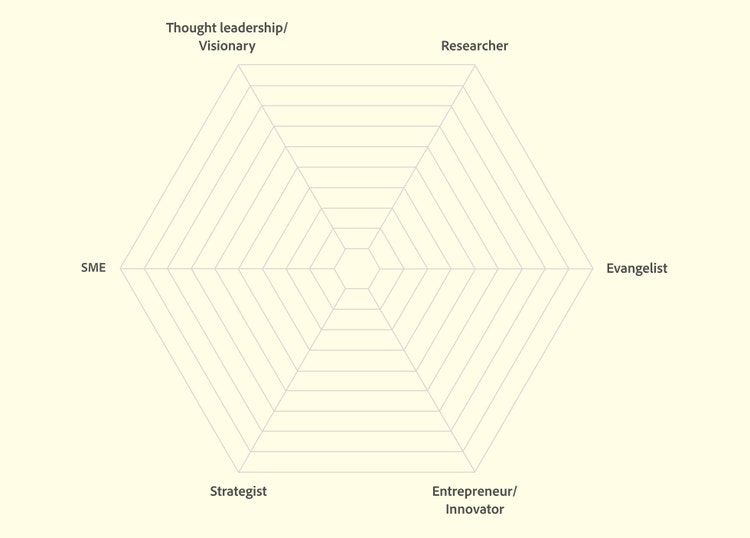The path to design principal: Mastering archetypes and defining success
The skills that can elevate your design career and your influence as an individual contributor

Illustration by Ellen Porteus
Drawing from personal experience, we’ve distilled the unique ways designers can approach leadership at the principal level and used them to create a set of archetypes that help illustrate the skills needed to succeed. Each principal designer embodies these archetypes and shapes them to their unique expertise and style of leadership.
By sharing these six archetypes we hoped to make it easier for Adobe Design’s upcoming designers to make informed choices about successful leadership as design ICs, but we believe they can also help guide designers across the industry shape their career paths. Becoming a principal designer isn't about following a single career path, it's about mastering a mix of skills and strengths to shape the career you envision.
Principal designer archetypes
We analyzed the skills we use daily, and looked at our industry counterparts, to create six principal designer archetypes. Each one represents a skill required to succeed at the principal designer level, but as individuals, every principal designer has a unique blend of strengths and backgrounds that form a unique leadership style.
Visionary: Being a visionary principal means predicting where industry trends are heading and coming up with innovative ideas and pioneering future trends. It's about envisioning the future and positioning yourself as a forward-thinker in your area of expertise.
Evangelist: This principal is expert at creating visibility for new ideas, products, or features both internally and externally. Promoting your work, so it has visibility beyond your immediate team, is key to establishing this type of leadership presence and building a wide internal audience is key to gaining traction. More than one of our principal designers has spent months at a time evangelizing new products within the company—both to gain internal support and to secure the resources for those products to be successful.
Researcher: A principal who embodies the researcher role forms hypotheses, takes part in research efforts, and grounds their ideas in the data they gather. This archetype focuses on ensuring that ideas are well-informed and backed by solid evidence. Sometimes this means finding ways to gather data on your own or seeking sources for the kind of data that will best support the story you need to tell.
Innovator: This entrepreneurial archetype presents new solutions or strategies for business ideas or products. This role involves identifying market gaps and developing innovative solutions to drive significant business results. More than one of Adobe Design’s principal designers has strong skills in this area. It’s most often seen when a principal’s work is focused on evangelizing new products or innovative features both inside the company and in the design community (at conferences, and in articles and interviews).
Strategist: This principal type emphasizes strategic thinking and orchestrates plans to effectively and collaboratively launch new initiatives or products. The strategist shows up most often on 1.0 products to help guide and inform strategies for launching them and facilitating alignment around key user-focused experiences.
Subject matter expert: The subject matter expert focuses on becoming the authoritative voice in a specific area of knowledge. By honing expertise, they become the go-to person for answers and opinions, solidifying themselves as an invaluable resource within an organization. Many of our principal designers are subject-matter experts in a specific knowledge area (like video or emerging technologies) and are sought out by product teams and leadership to consult on or lead projects in their specialty.
Archetype combinations: A different shape for every leader
The path to principal is demanding. It’s also deeply rewarding and offers the opportunity to make a significant impact on a company and on the products it builds. Archetypes provide some clarity on the skillsets needed to move up the IC career path towards principal designer.
To show how differently these archetypes can be combined, each of Adobe’s principal designers filled out a self-assessment, scoring themselves from 1 to 10. Charting the grades we give ourselves helps us visualize how each of us brings a distinct shape to the role—every cumulative score creates a slightly different shape.



Using the archetypes in your own career path
Every principal designer has their own unique combination of strengths, skills, and archetypes—and the same is true for the career path that led them to principal. Every designer has a different path, but there are some universal guidelines at the core of everyone’s unique journey:
Find your specialization: Principal designers are known for their specific areas of expertise. To excel in this role, discover what truly ignites your passion within design and hone your skills accordingly. If you’re not sure where to start, consider the archetypes and think about whether your strengths point you in a specific direction. Principal designers come in many forms, each with their own unique strengths and approaches. Explore the archetypes, but don't be afraid to create your own style by blending elements from different categories. Adobe Design principals have specializations (while one specializes in animation, another specializes in data visualization) that inform their work.
Build visibility: Climbing the ladder to principal often means extended exposure to the VP level or higher. Cultivate visibility within your product or team (and your design organization at large) so you can demonstrate your value and impact on the broadest scale.
Collaborate beyond borders: Successful principal designers work seamlessly with cross-functional partners, extending their influence beyond their immediate product team to shape the broader business and product landscape.
Measure your impact: To move up the IC career ladder you must be able to prove your impact on the business. This becomes more important the further up the career ladder you go. Remember: Your impact on the business is not the same as the amount of effort you put into doing your job or the number of tasks you take on.
A self-assessment for your own archetype map
For designers considering this career path, the most important thing to develop is your specialization—some kind of work, or pattern of work, that you enjoy or are good at (such as specializing in a specific area like data visualization, or in designing for 1.0 products). You don’t have to know everything about it, but the path to principal will be possible because you’ll be known for that knowledge and your leadership potential in the subject area.
So much work as a principal is self-directed and a specialty provides the anchor for that self-direction. It’s also what will create visibility for your work, enable you to transcend team boundaries to work with people outside of your immediate team, and provide the foundation for increasing your skills as you navigate this high-level IC career path.
Doing this archetype self-assessment can be a useful exercise and a guide to areas that you’re interested in. And, because the role is so much more self-guided than other roles before it, it can help identify skills that might need to be strengthened as you move up this career ladder.
Spend some time with this blank archetype map and rate how strongly you identify with each of the archetype areas on a scale of 1 to 10, with 10 being the strongest personal competency in an area and 1 the weakest. While you don’t need to strive for tens on all axes, looking at those where you’re weaker can provide some direction as to where a focus on improving your skills would create a more well-rounded approach.

If you’re aspiring to reach the principal designer level in your work, your career journey will be unique to you—each person will discover their own strengths, face their own unique challenges, and craft the role that aligns with their passion and vision. As you navigate challenges and seize opportunities, remember that the principal designer role is not a destination, but a journey of growth, impact, and continuous learning. Embrace the adventure and let your passion for design drive you forward as you shape the future of your career.